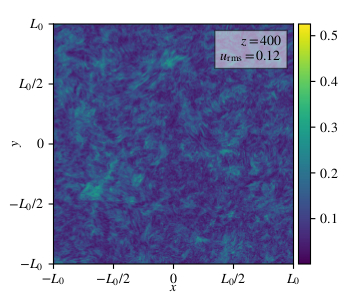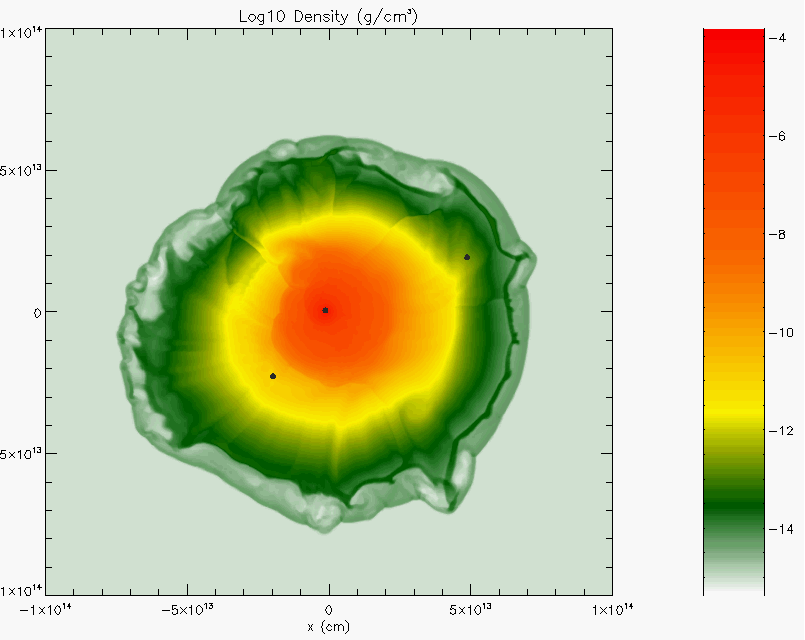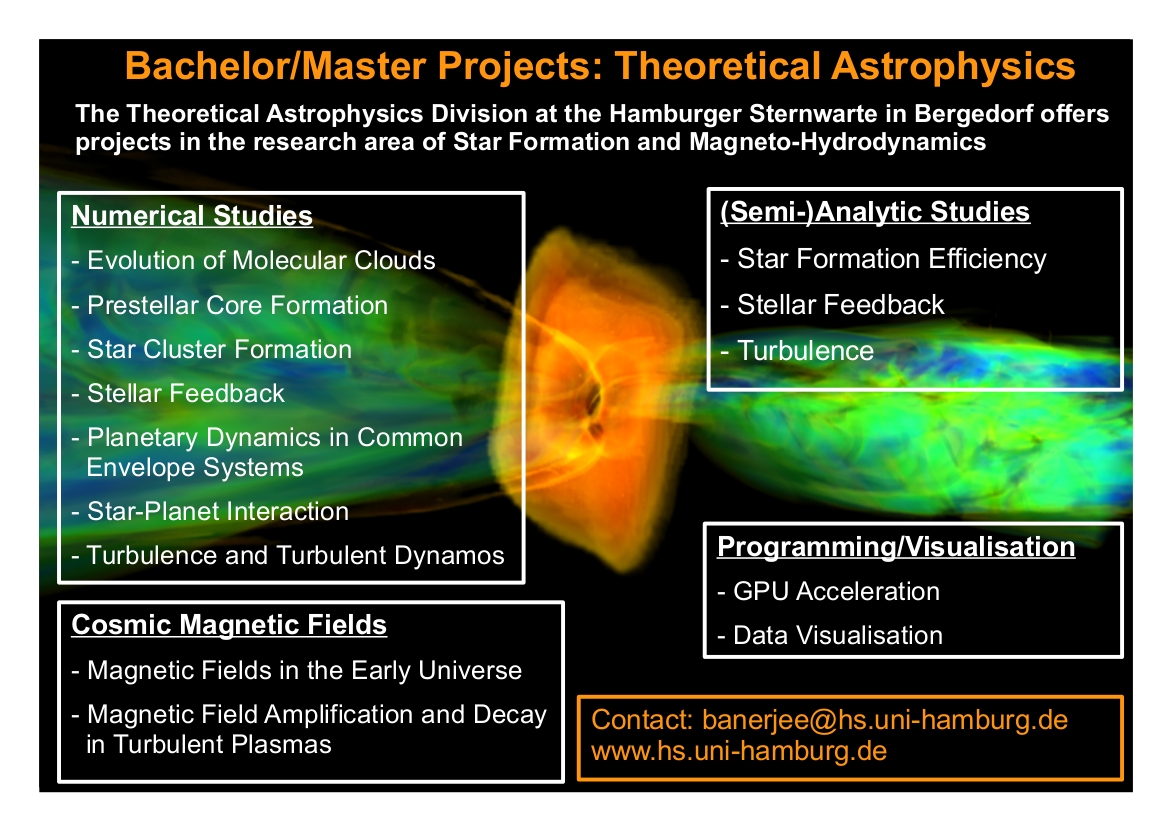Star formation & magnetohydrodynamics
We are the star formation and magneto-hydronamics (MHD) group. A large fraction of our research is based on numerical simulations with the FLASH code, an adaptive mesh refinement (AMR) integrator of the three dimensional coupled magneto-hydrodynamic equations. We are continuously improving our simulation software by including new physical modules (e.g. radiation transfer) and by accelerating the numerical computations with the help of graphic processing units (GPUs)
Our work involves:
- Star formation
- Cosmic magnetic fields
- Dynamo activity in turbulent plasmas
- Dynamics of extrasolar planet around massive stars and binary stars
- Time dependent radiation transfer
- GPU-accelerated simulations
Molecular clouds & star formation
Molecular Cloud Formation
Molecular clouds form by the condensation of cold and dense gas out of the warm, diffuse, and magnetised interstellar medium (ISM). This condensation is the result of thermal and dynamical instabilities, which arise due to processes on larger scales, such as gravitational instabilities or collisions of supernova remnant shells. On smaller scales, also turbulence is major ingredient in controlling the formation of dense structures. In this research project we analyse the formation of molecular clouds by turbulent and magnetised colliding flows and the subsequent star formation process.

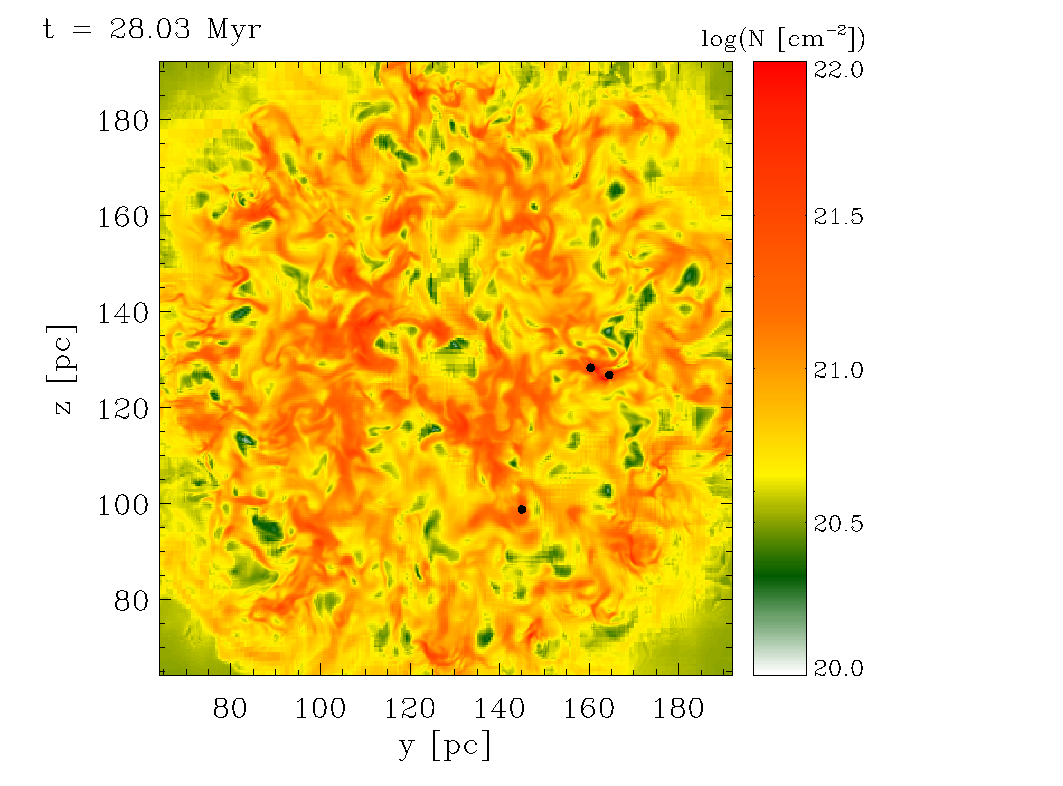
In the pictures above one can see the formation of a turbulent molecular cloud in the edge-on plane (top) and the face-on plane (bottom). The internal structure of the cloud is filamentary and the filaments and clumps are embedded in a diffuse, warm medium. Since the ISM is subject to heating and cooling processes, these substructures are in pressure equilibrium with the diffuse phase and are thus longlived entities, which eventually collapse to form a star (denoted by the black dots).
Molecular Cloud Formation With Varying Initial Conditions
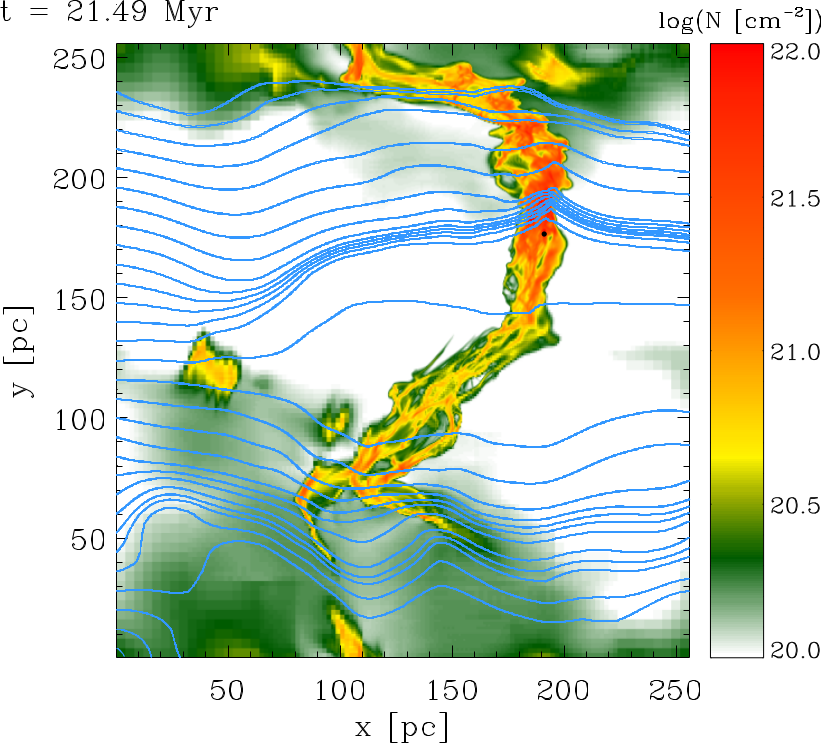
The above mentioned study assumes a perfect alignment of the colliding flows with the background magnetic field. But this scenario is an idealised one, since turbulence, galactic accretion and stellar feedback drive turbulence on a wide range of scales. Due to the interaction of the turbulent velocity field with the magnetic field, the latter will have a strong non-uniform component. Thus, large scale motions are able to move at an certain angle with respect to the local background magnetic field. If this is the case, the question arises whether molecular clouds are still able to build up and whether star formation is still the outcome. Our research group aims at understanding the outcome of such non-idealised initial conditions by studying this process with varying inclinations of the flow with respect to the background magnetic field and varying magnetic field strengths. The picture shows the column density as function of spatial coordinates (in pc) for an initial inclination of one flow of 60 degrees. The blue lines denote magnetic field lines and the black dot represents a sink particle. Click on the image to see a movie of this simulation.
Feedback in Molecular Clouds
Molecular clouds form stars with a broad mass spectrum, which tends to be bottom heavy (i.e. the distribution peaks at low masses) with a power-law tail at high masses. This distribution indicates that massive stars are rare. But despite their low occurrence, these massive stars are the most efficient agents in terms of stellar feedback. Since they are massive enough, they impact onto their parental cloud by means of ionising radiation, fast stellar winds and, finally, by supernovae feedback. During a supernovae, a huge amount of energy is released and injected into the ambient medium in a short amount of time, which is comparable to the overall energy input by the stellar wind. Due to this fact, supernova explosions are thought to disintegrate entire molecular clouds and thus stop the collapse of the cloud and its subsequent star formation process. On the other hand the feedback by massive stars can drive turbulence on molecular cloud scales. In this project we determine the influence of supernova feedback by massive stars on their parental molecular cloud. In detail we analyse the resulting cloud morphology and dynamics and study the impact on the formation of stars within the densest regions.
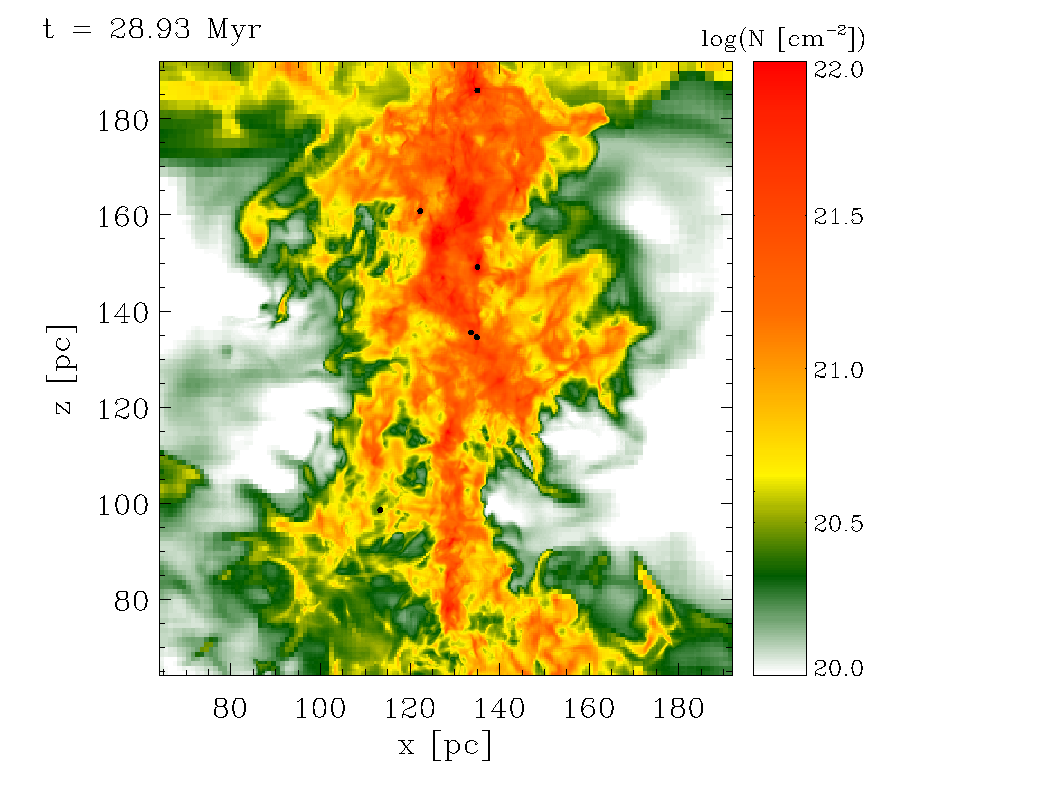
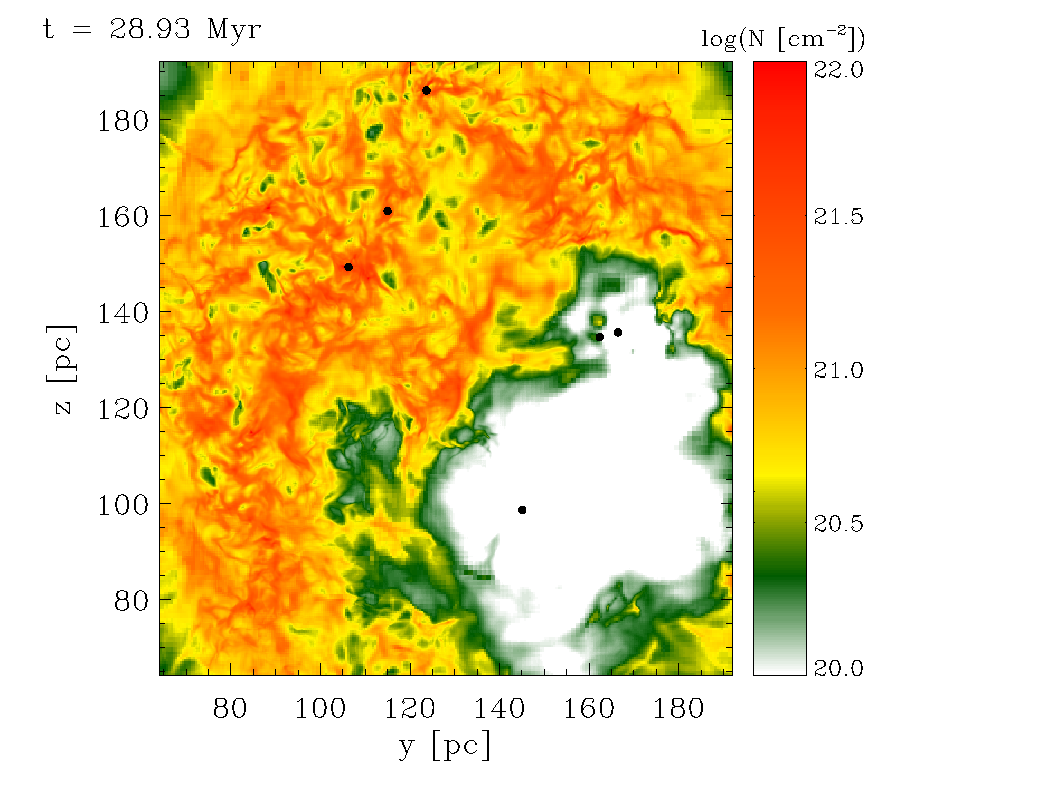
Time-dependent radiation transfer
Early Phases of Protostellar Discs – Studies with radiation transfer magneto-hydrodynamic simulations
All protostars are surrounded by a disc-like structure or proper Keplerian disc. Those discs are essential to understand the subsequent evolution of the protostar and are most probably the birthplaces of binary or multiple stellar systems, apart from being the nurseries of planets. Nevertheless, it is fairly unknown how the discs, and hence the protostars are decoupled from the infalling envelope and molecular clouds. Therefore we execute self-consistent simulations with radiation feedback of protostars and discs which are still embedded in an accreting envelope to track their late evolution. For this we employ our in-house developed hybrid characteristics radiation transfer scheme [Buntemeyer et al., 2016], which is build upon FLASH. Since the publication the solver has been extended to include the radiation of point sources as demonstrated in figure 4 (bottom), which are modeled by sink particles [Federrath et al., 2010] coupled to a star formation evolution model [Offner et al., 2009, Klassen et al., 2012]. Therefore these young stellar objects can irradiate the surrounding disk and envelope
The figure shows the result of a low resolution test simulation of a low mass molecular cloud collapse simulation. In this non-turbulent simulation a protostellar disc has already been formed. Since the central core has become optically thick, cooling by radiation is not effective any more. As a result the core heats up. If the central core contracts further the formation of a protostar is imminent.

A movie showing the time evolution can be downloaded here.
Cosmic magnetic fields & dynamo processes
We study magnetic heating across the cosmological recombination era by running 3D MHD simulations (see arxiv.org/abs/1805.05315 for details).
The baryon velocity field and the magnetic field over a 2D slice of the simulation box are shown below (click on the images to open videos showing the time evolution).
Evolving magnetic and kinetic power spectra can be watched here.
Dynamics of Extrasolar Planets around Massive Stars and Binary Stars
Since the 1990's hundreds of extrasolar planets have been detected in different kinds of planetary systems ranging from Jupiter-like planets orbiting their stars within the orbit of Mercury and planets around pulsars to possibly free floating planets which do not seem to be gravitationally bound to any host star. The diversity of extrasolar planetary systems requires different methods for the detection of the planets, e.g. radial velocity measurements and transit detections which are the two most successful detection methods.
A method that can be used to detect planets in systems with three or more objects, i.e. multiple planet systems or planets around binary stars, is the eclipse timing variation. It uses the detectable changes in the timing of transits compared to an undisturbed two-body system due to the gravitational acceleration or deceleration of the orbiting objects during close encounters.
So far, several planets around binary star systems have been detected via this method. Among them are planets in post-common envelope binaries where one or both of the stellar components evolved past the Main Sequence to White Dwarfs and during this evolution shared a common gaseous envelope with their stellar companion. The change in the gravitational potential of the binary combined with momentum transfer between planets and expelled gas can have significant effects on the dynamics of these planets.
An exemplary system is NN Serpentis.
Simulations with the FLASH code
On the one hand, possible outcomes of the stellar evolution include the expulsion or destruction of planets. On the other hand, a circumbinary disk could be formed and lead to gas accretion onto existing planets or even the formation of new (second generation) planets.
Therefore, we make use of FLASH, an adaptive mesh refinement simulation code for multiple physical demands, to perform full three-dimensional hydrodynamical simulations of planets around close binary stars during and after the common envelope phase. We trace the dynamics of the planetary system and follow the evolution of the expanding envelope.
The following images show slices of the density distribution from snapshots of one simulation.
| x,y-plane at t = 0 yr | x,y-plane at t = 0.15 yr |
|
|
 |
| x,y-plane at t = 0.27 yr | x,z-plane at t = 0.27 yr |
|
|
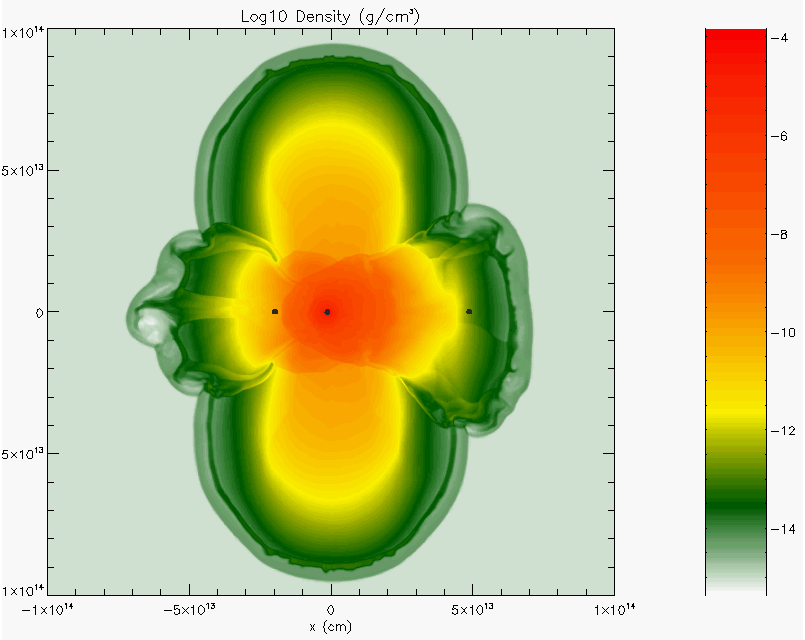 |
FLASH code development
We extensively use and contribute to the development of the FLASH code, a 3-dimensional (magneto-)hydrodynamic code for astrophysical supercomputing applications. The code is mainly developed and maintained at the FLASH Center of the University of Chicago.
We apply the FLASH code for studying a variety of astrophysical problems:
- magnetic fields and star formation in disc galaxies
- formation and evolution of molecular clouds, including feedback
- formation of star clusters
- dynamics of extrasolar planets around massive stars and binary systems
- and magnetic fields in the early Universe
We also develop new modules for the FLASH code to extend its applicability or to increase its efficiency and accuracy. Modules developed and tested at Hamburg Observatory so far include:
- time dependent radiative transfer (Buntemeyer et al., 2016)
- a GPU accelerated gravity solver (Lukat & Banerjee, 2016)
- mutual drag coupling between particles and grid as well as a Leapfrog integrator for particles in cylindrical geometries (Schäfer et al. 2020)
For our simulation projects and code development we use the Hummel cluster hosted at the Computing Center of the University of Hamburg (RRZ), and external HPC facilities, such as HLRN-IV.
If you have questions or if you are interested in using code modules, contact the FLASH group(flash"AT"hs.uni-hamburg.de) at the observatory.

